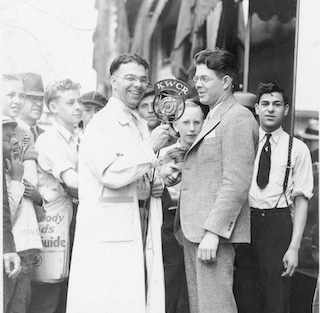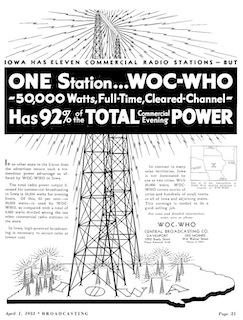
The second announcer in the U.S., and the first in Iowa, to do daily live “man on the street” radio broadcasts was Art Shepard. He broadcast from outside a business known as “The Little Flower Shop” in downtown Cedar Rapids. In order to mask a limp due to the effects of polio, Shepard was usually seen in public wearing a white “lab coat” with the name of the sponsor (in this case, People’s Furniture) embroidered on the back. Here Shepard interviews a regular guest, F.W. Woolworth downtown store manager Ralph J. McElroy. Using the air name Michael McElroy, the store manager would leave retail sales for a career himself in radio, later founding radio and television stations in Waterloo. Photo courtesy of Jeff Stein
(Publisher’s note: This is the first of a three-part series about the first century of radio broadcasting in Iowa. Part two of the series will appear in the May/June issue of IHJ. Photos and selected text are from the author’s book, “Making Waves: The People and Places of Iowa Broadcasting.”)
By Jeff Stein
The wonder of radio broadcasting — sounds literally flying through the air from far off places — has captivated us for decades.
First by using crystal sets often made at home using a Quaker Oats box, then with store-bought receivers requiring headphones, and soon with amplification developed by Iowa-born inventor Lee DeForest so sound could be heard through a speaker, the concept of families gathering around a device for information and entertainment has now been a part of our lives for more than five generations.
Commercial broadcasting in Iowa is celebrating its centennial this year. It is impossible to image life without it. Our experiences are tied to it — happy memories tied to songs we heard on the radio, tragedies remembered by “breaking news” bulletins. Broadcasting has in many ways united us as a people; the commonality of experiences we share instantaneously now thanks to radio, television and emerging digital technology were unheard of only 100 years ago.
Radio was especially important in rural areas, such as the Midwest. It became the great equalizer, allowing even those in the most remote parts of the country to experience the same things as those in major metropolitan areas. For the first time, news and information was heard in real time simultaneously across the continent; similarly, the finest dance bands performing in swanky hotel ballrooms in New York City or Chicago could also be heard in a rural home thousands of miles away.
Iowa’s state-run universities experimented with the new technology in the early years of the 20th century. An Iowa State College physics professor named “Dad” Hoffman set up a transmission line in 1911, stretching from the campus water tower to Engineering Hall, and established a wireless telegraph station. Such experiments were halted during World War I, but soon after, the first wireless telegraph station to be officially licensed by the federal government in the state was established at the State University of Iowa in 1919. It carried the call letters 9YA and is now known as WSUI.
Iowa’s First Commercial Station
Iowa’s commercial broadcasting history actually began across the Mississippi River in Illinois.
On Feb. 18, 1922, radio station WOC went on the air, licensed to the Karlowa Radio Co. of Rock Island. However, the costs to start the station and continue its operation were great, and owner Robert Karlowa quickly began to look for a buyer. Col. Bartlett Joshua “B.J.” Palmer purchased the station, and in May of that year, WOC’s license was transferred to the Palmer School of Chiropractic and moved to the school’s headquarters at 1002 Brady St. in Davenport, making it the first commercial radio station to be licensed in Iowa. It was also the first time a station was sold and its license moved to another state.

According to records from the Department of Commerce, which oversaw the earliest days of radio broadcasting, in June 1922, there were 11 Iowa radio stations licensed to broadcast. One year later, only eight of those original 11 were still in operation; however, another 18 had joined them, bringing the total number of Iowa’s licensed stations to 26 out of 592 nationwide.
Most of those early stations were owned by electrical or radio companies in towns such as Fort Dodge, Marshalltown, Newton, Gladbrook, Burlington and Sigourney, as well as larger cities such as Waterloo, Davenport, Des Moines, Council Bluffs and Dubuque. The interest of electrical companies in the new field of radio was easy to understand. Since the basis of radio is the process of harnessing signals within an electrical current, it was a natural for those who were installing electrical lines to Iowa’s rural areas to create demand for their own product.
But quickly the commercial benefit of the new medium became clear, and was the true inspiration for B.J. Palmer’s purchase of WOC radio. Palmer wanted to promote the chiropractic college founded by his father, D.D. Palmer, 25 years before.
The broadcast schedules of those early stations were far more limited than what we are used to a century later. One of the first program schedules, in July 1922, promised that WOC would be on the air each day at noon for a 15-minute chimes concert, followed by a weather report. Then the station would sign off until late afternoon when an “educational talk” (often about chiropractic care) would be delivered. The station would then be silent again until the dinner hour, when a chimes concert, baseball final scores, and market quotations would be aired, followed at 7 p.m. by an evening musical concert.
TO READ THE ENTIRE STORY AND OTHER FASCINATING STORIES ABOUT IOWA HISTORY, subscribe to Iowa History Journal.
